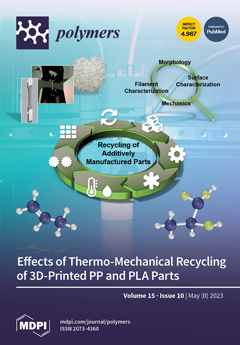In this research, we aim to investigate a flexible composite lithium-ion-conducting membrane (FC-LICM) consisting of poly(vinylidene fluoride-co-hexafluoropropylene) (PVDF-HFP) and titanium dioxide (TiO
2) nanoparticles with a TiO
2-rich configuration. PVDF-HFP was selected as the host polymer owing to its chemically compatible
[...] Read more.
In this research, we aim to investigate a flexible composite lithium-ion-conducting membrane (FC-LICM) consisting of poly(vinylidene fluoride-co-hexafluoropropylene) (PVDF-HFP) and titanium dioxide (TiO
2) nanoparticles with a TiO
2-rich configuration. PVDF-HFP was selected as the host polymer owing to its chemically compatible nature with lithium metal. TiO
2 (40–60 wt%) was incorporated into the polymer matrix, and the FC-LICM charge transfer resistance values (R
ct) were reduced by two-thirds (from 1609 Ω to 420 Ω) at the 50 wt% TiO
2 loading compared with the pristine PVDF-HFP. This improvement may be attributed to the electron transport properties enabled by the incorporation of semiconductive TiO
2. After being immersed in an electrolyte, the FC-LICM also exhibited a R
ct that was lower by 45% (from 141 to 76 Ω), suggesting enhanced ionic transfer upon the addition of TiO
2. The TiO
2 nanoparticles in the FC-LICM facilitated charge transfers for both electron transfer and ionic transport. The FC-LICM incorporated at an optimal load of 50 wt% TiO
2 was assembled into a hybrid electrolyte Li–air battery (HELAB). This battery was operated for 70 h with a cut-off capacity of 500 mAh g
−1 in a passive air-breathing mode under an atmosphere with high humidity. A 33% reduction in the overpotential of the HELAB was observed in comparison with using the bare polymer. The present work provides a simple FC-LICM approach for use in HELABs.
Full article






